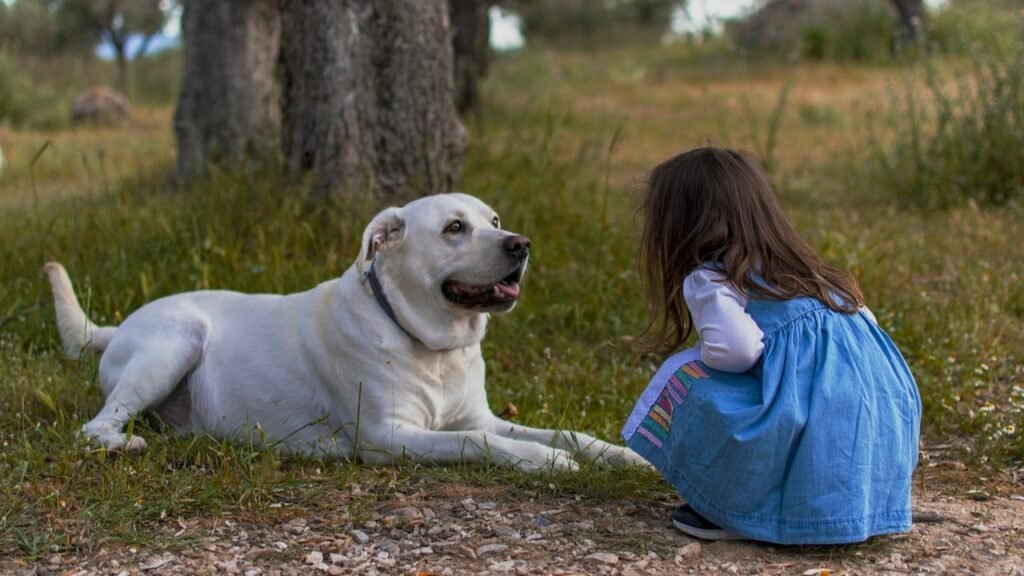Are you a dog-loving family contemplating your first canine addition? Or perhaps you’ve already welcomed a four-legged companion into your home? Either way, teaching your kids about responsibility and care towards their furry friends is important. Here are some practical, child-friendly ways to help your little ones learn how to care for a dog. Let’s start this rewarding journey together!

Educate Them About Dogs
Education serves as the foundation for teaching kids the responsibilities involved in dog care. It starts with teaching them basic behaviors and needs, which can help children understand why dogs behave a certain way and how to respond accordingly. Explain to them why they need a large dog bed that is comfortable for their furry friend, why they need to provide fresh water and food every day, and why dogs need regular exercise. Starting with the basics will help your kids develop empathy towards animals and learn how to meet their needs.
Additionally, knowing a dog’s need for daily exercise can inspire a routine walk, fostering an active lifestyle for both parties. Education also promotes empathy, as kids learn to discern signs of stress, discomfort, or happiness in their pets, fostering a nurturing relationship. Additionally, teaching kids about potential health hazards, dietary requirements, and grooming needs ensures the dog’s well-being, and instills in children a sense of responsibility and ownership.
Set Clear Responsibilities
Setting clear responsibilities for children is a key step in teaching them to care for a dog. This could include assigning tasks like feeding the dog, taking it for walks, or grooming. Allocating such duties not only helps children understand the daily care a pet requires but also instills a sense of accountability.
With each task completed, children gain confidence in their ability to take care of their pets, fostering a sense of pride and accomplishment. This process also allows them to experience first-hand the relationship between responsibility and the well-being of another living creature, which is a valuable life lesson.
Teach Basic Training Commands
As soon as they’re ready, your kids should be able to give out basic commands they can give dogs. These are the following:
- Sit
- Stay
- Lia down
- Come
- Heel
- Off
- Drop it
- Leave it
- Wait
- No
- Okay
- Quiet
Teaching kids basic training commands creates a communication bridge between them and the dog, enhancing the bond they share. The children learn to manage the dog’s behavior, ensuring a safe and harmonious environment. It fosters responsibility, as kids understand the impact of their instructions on the dog’s actions. Plus, the immediate response from the dog to their commands boosts their confidence in caretaking. This experience positively contributes to the overall pet-owning journey of the kids.
Encourage Bonding Time
Bonding time between your kids and their canine companion is a significant aspect of teaching pet care. This could involve play sessions, quiet cuddling moments, or shared activities like fetch games. Such interactions help children comprehend the emotional aspect of caring for a pet and foster deeper connections.
They learn to understand the dog’s communication signals, its likes and dislikes, and unique personality traits, all of which are integral to responsible pet ownership. Furthermore, this bonding time provides a rewarding experience, as children witness the tangible results of their care and affection in the dog’s love and loyalty towards them. It’s during these moments kids truly learn what it means to be a dog’s best friend.
Supervise and Provide Guidance
By overseeing the tasks assigned, you can provide immediate feedback, correct any mistakes, and reinforce positive behaviors. This active guidance helps them understand the correct way to interact with dogs, from correct handling to effective communication.
Your watchful presence ensures safety, while your advice based on personal experience aids in shaping their pet care skills. Over time, consistent supervision and direction can cultivate a deep understanding of responsible pet ownership, preparing them to independently care for their furry friend.
Lead by Example
Kids are often more influenced by what they observe in adults than by the rules set for them. When you model responsible pet ownership – from feeding the pet at regular intervals, taking it for regular check-ups, to showing kindness and patience toward the dog – your children will likely follow suit.
They’ll learn to mirror your actions and attitudes, understanding that pet care is a daily commitment. Moreover, by demonstrating empathy towards the dog, you will inspire compassion in your kids, fostering a deeper bond between them and their furry friend.

In conclusion, remember that teaching your children to responsibly care for a dog isn’t something that happens overnight. It’s a gradual process filled with teachable moments, bonding, and ample amounts of patience. By following these practical strategies, you’re not only fostering a beautiful bond between your kids and their canine companion, but also instilling valuable life lessons of compassion, responsibility, and empathy. Enjoy this beautiful journey of pet ownership with your little ones!

